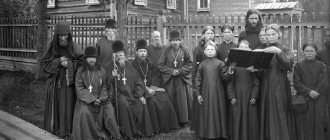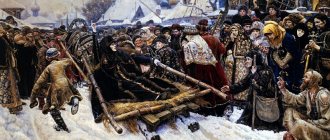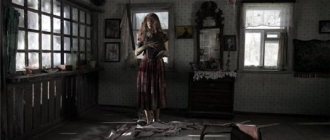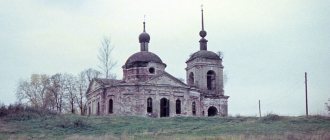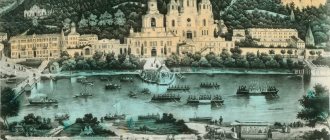How modern Old Believers live
The Old Believers attract close public attention. People who in the 21st century adhere to the traditions and foundations of centuries ago arouse curiosity. There is still a stereotype among the people that Old Believers live exclusively in taiga hermitages, reject the benefits of civilization and exist only at the expense of subsidiary farming and forest gifts. There is some truth in this, but not everything is so simple. In Russia, and in the Irkutsk region in particular, there are several agreements, whose representatives live not only in rural areas, but also in large cities. Moreover, it will not be possible to immediately distinguish an urban Old Believer from secular people. Modern clothes, fashionable hairstyle, social status make this almost impossible. However, no matter where the Old Believers live, they are distinguished by the depth of their faith, the preservation of traditions and family values. We talked with Alexander Kostrov, professor at the Department of World History and International Relations at ISU, about what the Old Believer concords in the Baikal region are like today and how their tribal way of life works.
No names or photos
As Alexander Kostrov notes, today the Old Believers are on a certain rise. One of the reasons for this is that people, rejecting the influence of the Western lifestyle model, are increasingly returning to their origins and roots. And it is the Old Believers who are the guardians of ancient Russian culture. Today, many of them return from abroad to their ancestral homeland in the countryside, developing subsidiary farming, relying on family and religious traditions.
According to rough estimates, there are currently about 2.5 thousand Old Believers and interested descendants in the Baikal region. No one can give an exact figure, since many agreements do not share the number of their followers. There are also communities that do not advertise themselves at all.
— In the Irkutsk region there are communities of different agreements. Each of them has their own achievements, problems, and everyday worries. These, for example, include the construction of churches in the regional center. To enhance the positive influence of the Old Believers on the Baikal society, the East Siberian Analytical and Educational Center is creating an inter-consensus Center for Old Believer Culture. Also, as part of the project “Old Believers of the Irkutsk Region: Role in the Cultural Development of the Region,” expeditionary research is being undertaken into various Old Believer communities. Old Believer births are of particular interest to researchers,” emphasizes Alexander Valerievich.
According to him, it is the Old Believer family, on the one hand, that is the value and custodian of the Old Believer tradition, and on the other hand, it shows the specificity of different consents and places of residence of their representatives. Be it a city or a remote taiga.
This year four expeditions were carried out in different territories of Eastern Siberia. One of them took travelers into the deep northern taiga. There they met a prominent representative of the Old Believers of the Chapel Concord. It’s worth mentioning right away that we will not name his name (like other heroes), since the followers of this consent strive not to advertise their personal data. They also try not to be photographed, much less get on the Internet. Representatives of other consents simply do not like advertising.
The only thing that can be said about the first hero is a 40-year-old man who has 12 children and a large household. He won the place for the estate from the taiga with the help of an ax, a tractor and his hardworking hands.
The chapels came to this region from Western Siberia in the first third of the 20th century. Then there was a thick curtain of taiga all around. However, they managed to clear the fields and cut the mowing. Now the settlement has several dozen households. This is a small village with its own established way of life. Despite existing stereotypes, the Old Believers greeted the guests quite cordially. The owner’s house, where the expedition members were invited, was clean and hospitable. At the same time, there were treats on the table prepared only from natural homemade and taiga products. There is simply no other food here.
According to Alexander Kostrov, the head of the family wears a blouse belted with a woven belt in everyday life. At the same time, he has his own set of clothes for each occasion: in addition to everyday clothes, he also has holiday and prayer clothes.
“When he puts on a blouse and a praying caftan, takes in his hand a lestovka (Old Believer rosary) and an assistant (a rug for bowing to the ground), then the bearded 17th century stands before us in full growth,” says the historian without a hint of irony. “The same can be said about his wife and children.”
Without TV and Internet
Almost all Old Believers can read Church Slavonic. In addition, they know Znamenny singing, which, unfortunately, is in oblivion among other groups of the Orthodox population today. All families live on their own farm and taiga. At the same time, it is not customary to take unearned money, so children, pensions, and various benefits are not received here.
Agricultural work among the Old Believers is so developed that they can even grow watermelons. It would seem an impossible luxury for the northern territories. During the season, they are engaged in harvesting forest products, but their main income comes from large sable hunts. For three months, men go far into the taiga, to hunting grounds, catch sable, and then sell the fur. Plus the Old Believers are excellent builders. They masterfully master woodworking techniques. And for this they do not need special education. Experience and skill are adopted from the older generation.
In a word, the chapels are indigenous people of the taiga. However, signs of modern civilization can still be seen here. For example, the farm has equipment: chainsaws, snowmobiles, boat motors, tractors, etc. Everything that is necessary for conducting agricultural activities and fishing. Often, hunting grounds are located 100 kilometers from home, and without snowmobiles it is impossible to get there in 40-degree frost through snowdrifts. They repair all units themselves. Since the Old Believers do not have the money to purchase powerful, expensive equipment, they purchase an old one and completely refurbish it down to the screw. That is, they take only “useful” equipment from the outside world, while avoiding “useless” and “harmful” ones.
It is noteworthy that such communities have a merchant who maintains their connection with the outside world. He goes out into the world and buys everything he needs. Moreover, his title is merchant, this is a traditional word. There is no other name for a sales agent here.
All residents speak beautiful Russian with archaisms. They don’t know many modern words, and most of them have never seen Soviet films. Therefore, when members of the expedition cited among themselves quotes from Russian cinema that had become popular, the chapels calmly and good-naturedly asked: “And what is this? About what?"
“In fact, this is a valuable sociocultural reserve in which the foundations of the national religious, social and economic culture are preserved. The house has a rich library of Church Slavonic books and icons in the style of old writing. They have their own icon painters. Services are held according to the old rules: vespers from 17.00 to 19.00 on Saturday, and Sunday services continue from 3.00 am to 8 am. At the same time, the prayer room is full of people of all ages during services. Men and women, dressed in prayer kaftans and sundresses, stand on opposite sides of the temple. They take from the world only what they need, and they do not need excess. They don't have Internet or TV. Old Believers rarely use mobile phones. And those that exist are push-button devices, the only function of which is communication. And not everyone even picked them up. Residents believe that if you need to contact the right person, you can simply go or visit him and talk.
An Old Believer church under construction in the village of Moty.
“And in the city of their views they hold fast”
Along with the taiga Old Believers, who best fit into the ideal image of most people, urban communities are also developing. Their families are less traditionalistic and not as large as those of the taiga inhabitants. The focus of their attention is the preservation and development of church and religious tradition against the backdrop of inclusion in the culture of modern society.
From this point of view, the Novozybkov Old Believers are of interest. Their distinctive feature is that representatives of this consent live in both villages and cities. They, unlike the chapels, use modern communications: they watch TV, use the Internet and modern mobile phones. As the rector of the community says, “God gave it, we must use it.” Outwardly, they do not differ from other townspeople, but in church life they try to observe everything strictly. Every Sunday, active representatives of the Irkutsk community gather for services in the house church at st. Medvedeva, 1. A church is also being built in the village. Mota and work is underway aimed at obtaining a site for the construction of a large city temple. The community includes representatives of various clans from the Baikal region, Transbaikalia, Khakassia, Krasnoyarsk Territory and Altai. These local families and those who arrived from other regions at different times have significantly enriched Irkutsk, both in terms of social capital and in terms of preserving and developing a deep traditional culture here.
As an example, the ISU professor cited the family of one of the active representatives of the Irkutsk city community of this agreement. Family members not only know the family tree up to the seventh generation, but also maintain close relationships with close and distant relatives. They respect the older generation and raise children from their numerous relatives together. In everyday life, they work in different professional fields: construction, accounting, education, etc. Moreover, in each of these areas there are achievements, which are also marked by state and public awards. The head of the family is actively involved in social activities and has a wide circle of contacts, which includes both scientists and representatives of various religious and cultural groups. Typically, in his many travels, he always visits Old Believer shrines and local communities, thereby trying to support the tradition in different regions and get acquainted with the local experience of its preservation. When Sunday or religious holidays come, the head of the family puts on prayer clothes and goes to church with his loved ones or prays at home.
Modern urban Old Believer
The most urban accord of the Old Believers can be called Belokrinitsky. As an example, Alexander Kostrov cites one Irkutsk entrepreneurial dynasty.
— Its head is an urban Old Believer of the 21st century. Actively engaged in entrepreneurial activities, in 1994, together with his comrades, he restored the historical community of his consent. In exchange for the temple seized in 1938, a building for a church was received (at Barrikad, 109) and a little later a plot of land for an Old Believer confessional cemetery. He visited many countries, where he also studied memorial culture. He used this experience to ensure that the Pokrovsky Old Believer cemetery became the best cemetery in eastern Russia. Today he passes on most of his business to his daughters and grandchildren. This Old Believer is actively involved not only in the economic, but also in the sociocultural relations of modern society,” says Alexander Valerievich.
- This is a modern, fashionably dressed person who enjoys all the benefits of modern civilization. At the same time, he provides charitable assistance to a club where people with disabilities play sports. Also, one of the areas of activity is helping migrants, including Old Believers. Now, with his active participation, a board of trustees has been created, which includes scientists, politicians, architects, builders and journalists, who have united to optimize the development of the churchyard and the construction of a new church.
“Today we see with our own eyes how diverse and multifaceted the Old Believers are. Its representatives live in both rural areas and urban agglomerations. And all these people from different Old Believer communities and places of residence are united by healthy traditionalism, which presupposes a deep knowledge of domestic religious and folk culture, as well as a desire for development based on family values and love for the Motherland. What particularly amazes me is the depth of faith, the degree to which traditions are preserved, and their sanity. They have a very balanced attitude towards themselves, towards the world, towards society. Old Believers do not force their views on anyone, but they hold their views very tightly. And this inspires respect,” emphasizes Alexander Kostrov.
According to the scientist, the Old Believers became the first champions of systemic traditional patriotism in our history. For in a situation where a choice had to be made, they always chose their own, and accepted someone else’s only when necessary and on the condition that it would not harm what was domestic. Therefore, even in modern times, Old Believers are the bright guardians of Russian national culture.
In the footsteps of the Old Believers
Programmer Anton Afanasyev was born in Sukhumi and moved to the Nizhny Novgorod region, as he put it, “in his conscious childhood.” But it so happened that, having read “In the Forests” and “On the Mountains” by Melnikov-Pechersky , he became seriously interested in the history and ethnography of the Old Believer regions. Anton travels around the region, looking for places of former settlements, studying history and life and talks about it in his illustrated blog. His two hobbies, photography and travel, came in handy for his extensive research. This is almost ethnography, only amateur. And popular - his blog already has eight thousand subscribers.
Anton Afanasyev is a blogger and ethnographer. Photo: AiF / Elfiya Garipova
“Not much is known about the life of the Nizhny Novgorod Old Believer hermitages,” says Afanasyev, “so I decided to study these places and see what is happening now in the lands of the Old Believers.”
Afanasiev first heard the word “monastery” when he began treasure hunting. Many diggers liked to wander with metal detectors in the area of Old Believer settlements, so Anton immediately got the impression that these were rich places.
“It’s quite difficult to find the remains of monasteries,” says Afanasiev. — Local residents often don’t even know that they live next to former monasteries: after all, sometimes all that remains is a dilapidated cemetery. Local shepherds often helped in the search: they turned out to be one of the few who knew where the settlements of the Old Believers were located.”
In places where entire settlements once existed, there are now wastelands with occasional crumbling buildings. Photo: From the personal archive of Anton Afanasyev
Over the course of several seasons, the blogger traveled to almost all the monasteries and found the descendants of local Old Believers. Some continue to adhere to the faith of their ancestors, while others have long forgotten about the principles of the Old Believers.
At first Anton thought that photographing the Old Believers would be difficult: “At first glance, they are quite secretive people and do not allow strangers to approach them. But no. They are ready to communicate."
Cultural monuments are gradually falling into disrepair, even though they are under protection. Photo: From the personal archive of Anton Afanasyev
Fact 6
There are Old Believers settlements all over the world: in America, Canada, China, Bolivia, Brazil, Argentina, Romania, Australia, New Zealand and even Alaska. For hundreds of years, Old Believers escaped persecution and dispossession. “They tore off the crosses. They forced me to give up everything. And ours abandoned. The grandfathers had to move from place to place three or four times a year. They will take icons, dishes, children and leave,” Uncle Vanya shares. - And they left around the world. And no one oppressed them there. They lived like Russians: they wore their clothes, their language, their culture, their work... And the Old Believers grow to the earth with roots. I can’t imagine how I could drop everything and leave. You will only have to rip it out with blood. Our grandfathers were strong."
Now Old Believers travel around the world to visit each other, introduce children, share clean seeds for the garden, news and experiences. Where the Old Believers are, the land that the locals considered infertile begins to bear fruit, the economy develops, and reservoirs are stocked with fish. These people do not complain about life, but take it and do their job day after day, little by little. Those who are far from Russia yearn for their homeland, some return, some do not.
Fact 1
The way of life of the Old Believers has remained virtually unchanged for more than 400 years. Uncle Vanya says:
An Old Believer cathedral was held, and they decided: not to drink vodka, not to wear worldly clothes, a woman braids two braids, does not cut her hair, covers it with a scarf, a man does not shave or trim his beard...
And this is just a small part. The thoroughness and vitality of these people is amazing. Take away their cars or electricity now - they won’t regret it much: after all, there is a stove, there is firewood, there is water from a well, there is a generous forest, a river with tons of fish, food supplies for the year ahead and experienced workers. I was lucky enough to attend a feast on the occasion of my daughter’s arrival. Oil painting. The table is full, there is everything that is not available in city supermarkets. I’ve only seen this in pictures in history textbooks: bearded men in shirt-shirts with tied belts are sitting, joking, laughing at the top of their voices, often you don’t even understand what they’re joking about (you still have to get used to the Old Believer dialect), but you’re happy with one thing the mood prevailing at the table. And this despite the fact that I don't drink. Old Russian feast in all its glory.
Fact 2
Despite the fact that they live on the land, their earnings exceed those of city dwellers.
The city people there are much more tense than I am here,” says Uncle Vanya. - I work for my own pleasure.
In the settlement, almost every Old Believer has a Toyota Land Cruiser in their yard, a spacious wooden house, from 150 square meters for each adult family member, land, vegetable gardens, equipment, livestock, supplies and supplies... They talk in terms of millions: “On one apiary I raised 2.5 million rubles,” Uncle Vanya confesses. “We don’t need anything, we’ll buy everything we need. But how much do we need here? In the city, everything you earn goes towards food, but here we grow it ourselves.”
“The family of my niece came here from Bolivia, sold equipment and land there, and brought with them 1.5 million dollars. They are farmers. We bought 800 hectares of arable land in the Primorsky Territory. Now he lives there. Everyone is happy, everyone lives in abundance,” continues Uncle Vanya. After this, you think: is our urban civilization really that advanced?
Reform
In 1656, a Local Council , convened by Patriarch Nikon . Its result was a reform condemning double-fingering, that is, making the sign of the cross with two rather than three fingers. All those who were baptized "incorrectly" were anathematized, declared heretics and excommunicated from the Trinity .
In essence, the results of the Moscow Council were such that the Old Believers, because of their customs, found themselves in an illegal position. And at the council of 1667, new church books and rituals were approved.
Church - on bricks
Anton Afanasyev not only studies historical places with great attention, but is also keenly interested in people living in abandoned, remote corners of the region. Here he finds subjects for his photographs.
Anton talks about meeting the bearded fireman Sergei and his partner, and shows photographs. The stokers heat the local school, which is located in the former noble estate of Berdnikov . To heat the school and teacher's house, they must haul and burn 12 wheelbarrows of coal every day. Sergei told Afanasyev that in the courtyard of this former estate there used to be two marble steles - of Berdnikov himself and his wife.
Sergey the fireman is a resident of the northern regions of the Nizhny Novgorod region. Photo: From the personal archive of Anton Afanasyev
“So, according to Sergei, in the early 90s, both steles were “taken away” somewhere,” says Afanasyev. - And then a rumor spread that the son of this same Berdnikov, a serious businessman from France, intends to visit his native place! And he’s even thinking about a joint venture in his father’s homeland: he wanted to restore a local factory. Sergei said that they were scared, the whole village was looking for these steles: it was awkward in front of a foreign guest. And they found it! They were lying in someone’s backyard.”
In the north of the region, people live poorly - people do not care about preserving cultural heritage. Photo: From the personal archive of Anton Afanasyev
The steles were returned to their original place. Only there was nothing left to restore: the walls of the factory had long been dismantled, as well as the local church.
Anton tells how in the region, far from more or less large cities, signs of desolation are visible everywhere: devastation is all around, there is almost no work. Everything that was possible was taken away into bricks.
Young people leave, old people stay. Photo: From the personal archive of Anton Afanasyev
Returning to the conversation about monasteries, Afanasyev sighs: “Of course, I am not an ethnographer, although I am now receiving a second – historical – education. I simply photograph what I see and try to describe what remains. I understand: time does a lot to destroy Old Believer settlements. But if they had been properly cared for, many things would probably have been preserved for posterity. And maybe it’s not too late?”
Surviving monastery
Afanasyev managed not only to photograph the people themselves, but also to film the service in the only surviving and operating Nizhny Novgorod monastery - Malinovsky. It was built at the end of the 19th century with the money of the richest merchant-industrialist Nikolai Bugrov (the same one who owned the rooming house in Nizhny Novgorod, known as the prototype of the rooming house from Gorky’s play “At the Lower Depths”). During the Soviet period, utility rooms were built in the monastery church. Now almost all the frescoes have been completely restored, since since July 1994 the Malinovsky Skete complex has been placed under state protection as a historical and cultural monument of regional significance.
Church choir of the Malinovsky monastery. Photo: From the personal archive of Anton Afanasyev
In the city, Anton rarely goes to church, but at the Malinovsky monastery he wanted to watch the service. Knowing that Old Believers, as a rule, do not allow anyone other than fellow believers to go further than the vestibule, the photographer stood there and watched the service begin.
There is a worship service in progress. Photo: From the personal archive of Anton Afanasyev
“One woman from a church shop saw me,” says Anton. “She turned out to be the wife of Father Alexander , who conducted the service. She invited me to come in, write a note about my health, and even take pictures of the interiors and the service itself, which I didn’t expect at all! Obviously, my interest in what was happening played a role. After the service they even invited me to dinner.”
Lunch after the service. Photo: From the personal archive of Anton Afanasyev
Fact 3
There was and is no centralized management in the community.
No one in the community can tell me what to do. Our agreement is called “chapel”. We unite, live in villages and gather for services together. But if I don’t like it, then I won’t go and that’s it. “I’ll pray at home,” says Uncle Vanya.
The community meets on holidays, which are held according to the charter: 12 main holidays a year.
We don't have a church, we have a house of worship. There is an elected elder. He is elected according to his talents. He organizes services, births, baptisms, funerals, funeral services. In addition, not every father can explain to his son why one thing can be done and another cannot. This person must also have the following knowledge: the ability to persuade, the ability to explain,” notes Uncle Vanya.
“They will kill for an icon”
“This grandmother told me that lonely old women are deceived by buyers,” says Afanasiev. — People come from the city and voluntarily and compulsorily exchange ancient icons for new ones. I ask why you agree. He answers, we are afraid, they say: they will come at night, rob or kill for these icons. It is clear that they are making rude money from these grandmotherly icons. Not only icons are taken away, but also preserved church utensils. The old women also looked at me with suspicion at first: was I a junk dealer?”
A descendant of the Old Believers, Nina Alexandrovna, is afraid of icon buyers. Photo: From the personal archive of Anton Afanasyev
Old Believers' churches are mostly destroyed by time and the barbaric attitude of those around them. For example, in the former Old Believer community of Budilikha, the church is already in disrepair: the boards are being pulled away onto fences, and the dome has long been lying on the ground.
Destroyed church in Budilikha. Photo: From the personal archive of Anton Afanasyev
The situation is the same in the ancient village of Martynov: the church has been destroyed and is in terrible condition. A little time will pass, and all that will remain from it is a pile of old boards and logs. If they don't get stolen too.
“They say that there is nothing and no one to restore these churches,” Afanasiev shakes his head, “they say that there are fewer and fewer Old Believers here every year - they are all young, either in Orthodoxy, or not believers at all.”
The church onion is lying on the ground. Photo: From the personal archive of Anton Afanasyev
